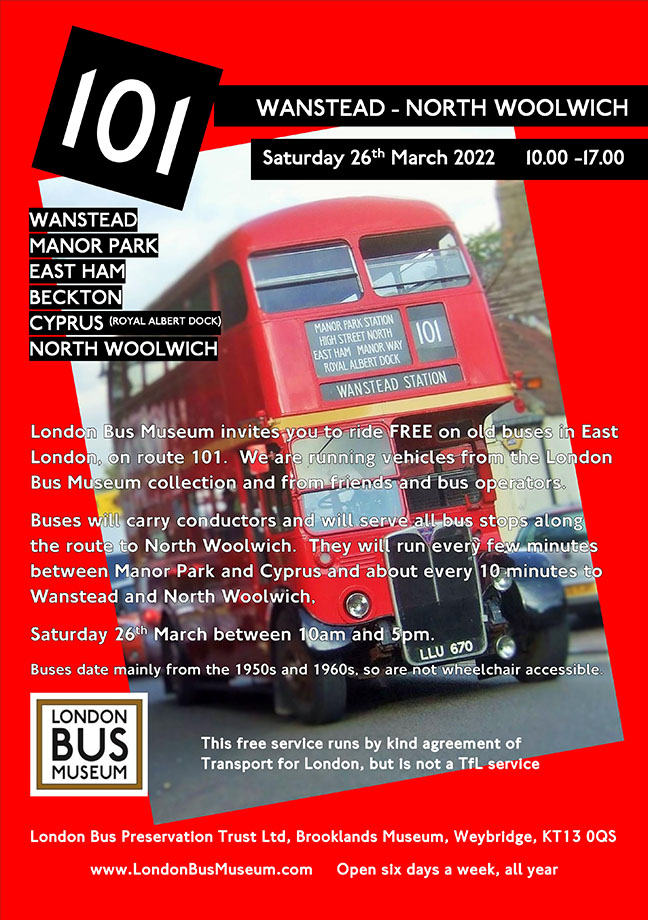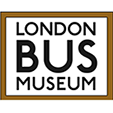Route 101 Running Day ~ Saturday 26th March
Route 101 (Wanstead to North Woolwich)
An east London route known in its heyday for a one-minute frequency across East Ham. Successively the last home of pre-war TDs, utility Guys and Central Area STLs. The main route operated by Upton Park garage throughout its life.
We will be running route 101, primarily with RTs and Routemasters, with operations between 10:00 and 17:00. Buses will run every few minutes between Manor Park and Cyprus (Royal Albert Dock) and about every ten minutes to/from Wanstead Station and North Woolwich. In addition, a limited number of journeys will recreate the summer Sunday extension (until 1954 only) into the country at Lambourne End, see timetable for details.
- Bus types are planned to include the following, which worked the route for different periods between 1951 and 2012: RT, RM, RML, DM, T, TA : 101 bus list [PDF]
- LBM members are welcome to join the Museum buses heading to route 101 on Saturday 26th (Campbell Gate at 0815, return estimated 1900).
- Timetable - updated [PDF]
- Update: an additional evening service will operate between 1930 and 2130, thanks to our friends at London Bus Company and Epping Ongar Railway.
- Maps
- Gallery
- History
- Flyer [PDF]
and ...
- Route 81 Running Day (Hounslow to Slough, journeys to Windsor) on 12th June.
- RTs on route 37 Running Day (Putney Heath to Peckham) on 1st October.

Route 101 Gallery
![Upton Park garage was pioneering when it opened in 1907 for its clear open area without pillars, setting the trend for all future bus garages. Two RTs from the London Bus Company marked the last day by working route 101 [Peter Osborn]. Upton Park Garage](https://www.londonbusmuseum.com/wp-content/uploads/2022/01/DSCF3891-2.jpg)
East End route 101 - a brief history
The Royal Albert Dock opened in 1880 at the southern end of East Ham parish, built on marshland east of the Royal Victoria Dock, with direct access eastward to the Thames at Gallions Reach. The Cyprus housing estate for its workers was built on the north side of the dock in an isolated spot on the East Ham Levels; it was named for the island which had come under British administration in 1878. East Ham itself was rural until developed in the last decade of the 19th century. The new East Ham Council opened a tram route in 1901 running south from Wanstead Flats via Manor Park and East Ham to Cyprus Ferndale Tavern for Royal Albert Dock.
Twelve years later, the LGOC started running buses along the tram route and extending to Wanstead in the north and North Woolwich Free Ferry in the south. A paddle-steamer-operated Free Ferry between North Woolwich and Woolwich was introduced by the Metropolitan Board of Works in 1889; the paddle-steamers were replaced by a roll-on/roll-off ferry in 1963. After the first world war, the existing road from Wanstead to North Woolwich was designated the North Circular Road, until the South Woodford to Barking relief road was built in the 1980s.
The LGOC bus route from Wanstead to North Woolwich was initially numbered 54 but renumbered 101 in March 1914. From 1914 to 1954, with the exception of the second world war, the route was extended northeast on summer Sundays to run to Lambourne End in Hainault Forest, an extension longer than the route itself. From 1919, operation was taken over by Upton Park garage.
On the formation of the LPTB in July 1933, acquisition commenced of the remaining London independent operators. The Leyland Titan was a popular model with the independents and all petrol-engined examples were based together at Upton Park. These were used on the 101, which retained them longest and became the last route to operate them for London Transport, in September 1939.
The tram service to Royal Albert Dock had been taken over by the LPTB in 1933, but instead of being converted to trolleybus was abandoned in favour of an increased service on the 101 in October 1936. The 101 service was restructured to run in two overlapping sections, Royal Albert Dock to Wanstead and North Woolwich to Manor Park. This overlapping service was a feature of the route into the 1970s. The frequency continued to increase and by 1951 the 101 ran every minute through East Ham, making the 101 London’s most frequent bus service.
Wartime utility Guys (including the Museum’s G351) took over the 101, but were poorly built and were extremely unpopular with drivers. The last dozen were withdrawn at Upton Park from the 101 in December 1952. Older STLs took over for a further eighteen months, the last Central Area examples again running on the 101 in June 1954. They were replaced on the 101 by RTs.
The conversion to RT marked the beginning of the decline of the 101, mirroring the decline of the docks. In October 1971, RTs were replaced by Routemasters at weekends, in the form of RMLs, and standard RMs took over during the week in October 1972. The route was converted to one person operation in September 1982, with Leyland Titans again but now the rear-engined T class, a year after the final closure of the Victoria & Albert Docks.
The Docks had been badly bombed in the war, but much of the housing at Cyprus being lost and replaced after the war by ‘pre-fabs’. With the economic desolation of the Docklands in the 1980s, Cyprus was the location of the first new private housing development in the area for many years, and the first sponsored by the London Docklands Development Corporation. Now the only reminder of the old Cyprus is the erstwhile Ferndale Hotel building, now private housing.
In December 2005, the 101 was diverted east of Cyprus to run to Gallions Reach Shopping Park. The Cyprus to North Woolwich section already being covered by route 474. The 101 and 474 continue today in this form, the 101 now operated by Go Ahead London using Wright Gemini-bodied Volvos from River Road garage and the 474 by Stagecoach using Enviro400 hybrids from West Ham.
Route 101 - maps
Route 101 maps [PDF]





![Leyland Titan TD2 TD37 with Birch body (ex AG Summerskill) at East Ham [DWK Jones]](https://www.londonbusmuseum.com/wp-content/uploads/2022/01/101-TD37-Manor-Park-Birch-body-ex-AG-Summerskill-LesSColl.jpg)
![G403 and our G351 at East Ham Town Hall on 16 September 1951 [A B Cross] G403 U 101 EAST HAM 16091951 wG351 AB CROSS](https://www.londonbusmuseum.com/wp-content/uploads/2022/01/G403-U-101-EAST-HAM-16091951-wG351-AB-CROSS.jpg)
![Saunders RT1921 at North Woolwich [Fred Ivey] 101 RT1921 U North Woolwich](https://www.londonbusmuseum.com/wp-content/uploads/2022/01/101-RT1921-U-North-Woolwich.jpg)
![RT3845 at Cyprus (Royal Albert Dock), 1975 [Graham Burnell] 101 RT3845 Cyprus 1975 Graham Burnell 300](https://www.londonbusmuseum.com/wp-content/uploads/2022/01/101-RT3845-Cyprus-1975-Graham-Burnell-300.jpg)
![RT4092 on the 101 at East Ham [Fred Ivey] RT4092 at East Ham (Fred Ivey)](https://www.londonbusmuseum.com/wp-content/uploads/cache/2021/12/101-RT4092-East-Ham-scaled/1808651382.jpg)
![Closure day of Upton Park garage (16/9/2011), RT3062 entering the garage [Peter Osborn] closure day of Upton Park garage (16/9/2011), RT3062 entering the garage. Peter Osborn](https://www.londonbusmuseum.com/wp-content/uploads/2022/01/DSCF3885.jpg)
![RML2454 at North Woolwich [David Flett] RML2454 at North Woolwich [David Flett]](https://www.londonbusmuseum.com/wp-content/uploads/2022/01/101-RML2454-North-Woolwich-0682-David-Flett.jpg)
![RM77 with the tops of a line of cranes at Royal Albert Dock [Kim Rennie] RM77 with the tops of a line of cranes at Royal Albert Dock [Kim Rennie]](https://www.londonbusmuseum.com/wp-content/uploads/2022/01/101-RM77-cranes-at-Royal-Albert-Dock-Kim-Rennie.jpg)
![T649 (rear) at North Woolwich with RML on 69 and Titan on 58 [David Henderson collection] T649 (rear) at North Woolwich with RML on 69 and Titan on 58 [David Henderson collection]](https://www.londonbusmuseum.com/wp-content/uploads/2022/01/101-T649rear-69-RM1625-North-Woolwich-DHendersonColl.jpg)
![Go Ahead London WVL469 Volvo B5LH / Wright Gemini: route 101; Beckton Bus Station : 24 November 2019 [David Harman] Go Ahead London WVL469 Volvo B5LH / Wright Gemini: route 101; Beckton Bus Station : 24 November 2019 [David Harman]](https://www.londonbusmuseum.com/wp-content/uploads/2021/12/Route-101.jpg)
![Stagecoach ADL Enviro 400H MMC 11037: route 474 ; North Woolwich; 24 November 2019 [David Harman] Stagecoach ADL Enviro 400H MMC 11037: route 474 ; North Woolwich; 24 November 2019 [David Harman]](https://www.londonbusmuseum.com/wp-content/uploads/2022/01/Route-101-2.jpg)